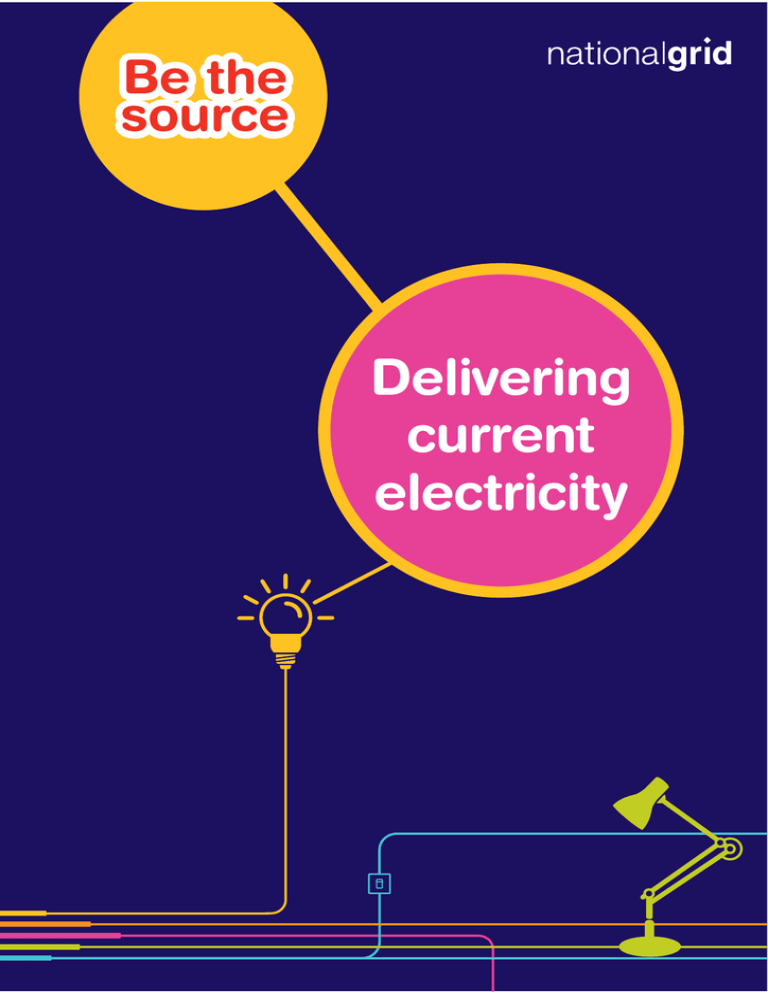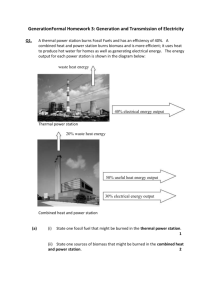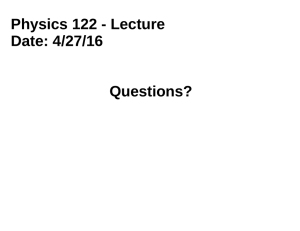Delivering current electricity
advertisement

Be the source Delivering current electricity Delivering current electricity ectricity t i ity to t your your home ho So, the National Grid is part of a gigantic simple circuit connecting houses, factories, hospitals and schools to the power stations. There is something extra... ...the Transformers! Why do we need transformers? Why are the power line cables always in sets of 3? Why do we need such high voltages for the power lines cables? Why do we use alternating current (AC) to deliver electricity to or homes? A simple circuit The houses are the load. The turbine and generator is the power supply. The National Grid lines connect the power supply to the load. Some facts Why do the cables heat up? In the UK there are more than 180 big power stations. There are millions of homes, schools and factories. This and the fact that energy can’t be stored is what makes the Grid so difficult to operate. It’s like having lots of batteries and lots of bulbs in the simple circuit and having to know which ones will be switched off/on and when! Whenever an electric current flows through a wire the wire heats up. This is known as joule heating. As the negative electrons try to move past the positive ions in the wire they attract them and so make the ions vibrate more strongly. Thin wires heat up more than thick ones. The thicker the cable the less the resistance (we could imagine that a thicker cable represents a wider roadway) and the smaller the resistance, the less the heating. The cables of the grid are already nearly as thick as a rolling pin and arranged in bundles and are therefore very heavy. The pylon would have to be a lot stronger to carry thicker and heavier cable or more in a bundle. Demand (load) must be matched by the supply (generation power supply). This can be more than 50 000 MW and requires that people sit down and forecast what the load will be and how to supply it with the available power stations. All this is done in one place in Berkshire, the National Grid Control Centre. The Super Grid (voltage greater than 200 kV) cables are more than 20 000 km long. Like all conductors, these cables are heated by the current that flows through them. In the simple circuit the current is very small and so the heating is small anyway. The wires are still thicker than the filament of the bulb. We have made the wires of the Grid about as thick as they can be, so if we want to keep heating losses down the next way is to reduce the current. The power P or heat spent (dissipated) in a resistor (wire or bulb or national grid conductors, for example) is current x voltage. P=IxV But we know from Ohms Law that V= I x R, so P=Ix ( I x R ) Or P=I2 x R We can see from this that if the current is halved then the heating, P, is only a quarter of what it was. This means losses due to heating are reduced by 75%....a huge amount. The reason is simply because the heating effect goes up as the square of the current. As we cannot reduce R any more it makes sense to reduce the current. But if we reduce the current we must increase the voltage in order to keep the power P the same. The current is reduced simply by increasing the voltage. This ensures that the power transmitted stays the same but the joule heating effect is reduced. Easy to say but not so easy in practice! What is required is a transformer. Remember that it is having to transform voltages at very high power. This means the transformers at an electricity substation are big – some weigh more that 270 tonnes before oil is added – that is bigger than whole diesel locomotives. The transformer is a neat trick played on nature. You will know that if a wire is moved in a magnetic field a voltage is generated between the ends. The wire “experiences” a moving magnetic field. Now imagine an electromagnet with a second coil placed near it. Moving the second coil will generate a voltage across the ends of the coil. Now keep the second coil stationary and put AC into the electromagnet (AC varies with time). The magnetic field of the electromagnet will increase and decrease and the second coil will “experience” an increasing and decreasing magnetic field. The second coil will “think” it is being moved in a magnetic field and a voltage will be generated across the ends of the coil. This is a transformer, the electromagnet is the primary coil and the secondary coil is connected to the load. If the number of coils in the primary and the secondary, is the same, the voltage across the secondary is the same as the voltage across the primary. With more coils or turns on the secondary the voltage is increased, step up; and with fewer turns we have a step down transformer. Primary winding How ow is the th current reduced? d d Step down transformers are used for welding, cooking hobs, electric furnaces for melting metals. In these cases a high current for the heating effect is desirable. Step down transformers are used on the grid for bringing the high voltages down to a safer 230 V for our domestic use. Step up transformers are used in fluorescent tubes, X-ray machines and of course on the Grid to reduce the current by increasing the voltage. VS / VP = NS / NP If no energy is wasted in the transformer Power in = Power out VP x IP = VS x Is Of course in reality there are considerable losses due to heating and these big transformers are oil cooled. Although the % of energy lost on National Grid transformers is small, they have an efficiency of 99.8% under normal operating conditions. The fact that they transmit such large amounts of power means a lot of heat is generated on the transformer. This heat is removed by circulating oil around the windings. Magnetic Flux ǩ Secondary winding Np turns Ns turns Primary current Ip Secondary current Is + – Primary voltage Vp Secondary voltage – + Transformer Core Questions uestio Answered Answered d Do transformers work with AC and DC? Transformers will only work with AC. The first power station was built in London in 1882 and used DC. At that time engineers struggled to decide whether to use DC or AC. AC won because electricity can be transmitted at high voltage and lower current so reducing energy losses. Currents are still high however and can be more than 5000 Amperes – compare that to the current of 10 A in your kettle! Each generator has three coils and so produces three outputs, each one third Line 3 of a revolution behind the other. These are the three phases and each is carried on a separate cable which is why the conductors of the power lines come in sets of three. The neutral or return current is sent through the ground from your house back to the power station which is one reason why good earthing is so important! In some countries all three phases are used in houses but in the UK we only use one single phase in homes. Factories use all three phases for greater power. Line 1 Neutral Line 2 High voltages allow us to transmit at lower current so why not use even higher voltages? The power line cables are supported from the pylon and separated from them by ceramic insulators. As the voltage increases, better and heavier insulation is needed. In any case at very high voltages the air begins to break down allowing current to leak even if a spark is not produced. The National Grid has arrived at a happy medium of 400 000 V for the Supergrid. Some figures Real power lines may carry currents of more than a thousand Amperes. At a phase-to-earth voltage of 160 000V this implies a power of 480 000 000 W or 480 MW shared across 3 phases. If we use conductors in bundles, rather than singles, we can substantially increase the current a line can transmit. If the resistance of the cable is 0.1 Ohm per kilometre the voltage drop for each kilometre is 1000 A x 0.11 or 100 V. The energy dissipated per kilometre is 1000 A x 100 V or 100 kW. So even high voltage lines can dissipate a great deal of energy through heat losses. This is why it is important to keep the current and the resistance as low as possible. GCSE Exam specifications at GCSE AQA spec A P1.4.2 The National Grid AQA Physics 3 13.9 How do transformers work? Edexcel P1 5.12 Generation and transmission of electricity OCR Physics B P2b Find out about the National Grid OCR 21st C Physics A, P 5.4 How is mains electricity produced? A simple simp e circuitt The lamp is the load. The battery is the power supply. – + The wires connect the power supply to the load. Education & Skills National Grid National Grid House Warwick Technology Park Gallows Hill Warwick CV34 6DA www.nationalgrideducation.com Securing our energy supply for future generations



